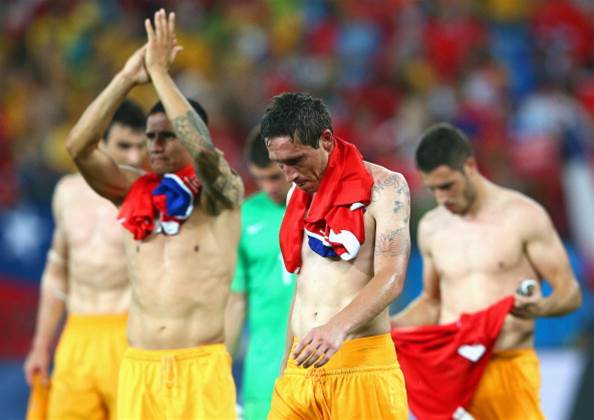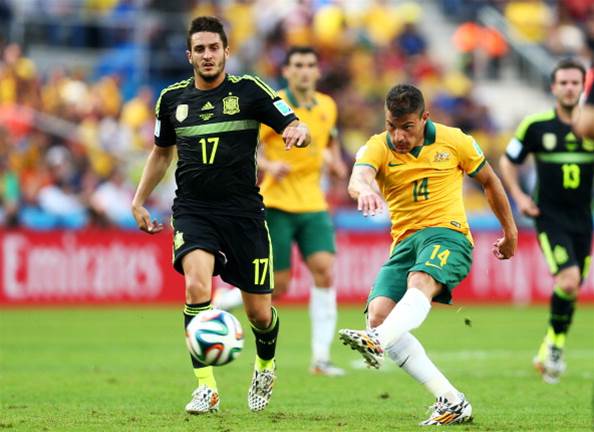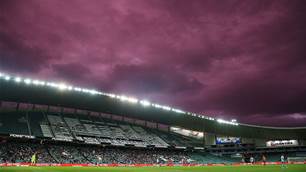As Socceroos fans don the polar-fleece and look towards another World Cup dawn, we cast our mind back to 2014. Less has changed than you might have thought…
The 2018 World Cup was meant to be Ange Postecoglou's judgement day.
2014’s tournament slammed down two markers for the next four years to be judged on – Australia wanted squad regeneration and the birth of a new footballing ideology.
So, given that the 2014 World Cup squad is largely acknowledged as a young, inexperienced side gaining crucial experience, how is it that four years later, only six of Bert van Marwijk’s 23-man team have prior World Cup experience?
What went wrong?
The Socceroos now face a mirror image of 2014 – another young, fresh-faced squad ready to build for the future.
Postecoglou’s resignation may have denied us the final opportunity to assess our tactical development, but we can still summarise how Ange’s 2014 World Cup squad matriculated into the Socceroos we have today.
These are the final winners and losers from the Postecoglou era.
WINNERS
Massimo Luongo –
As QPR’s reigning Fans’ Player of the Year, 25-year-old Luongo is one of the success stories from Ange’s reign.
Although he didn’t appear at the 2014 World Cup, his technical ability and squad experience at three major tournaments are set to make him one of van Marwijk’s key players in Russia and a Socceroos stalwart for years to come.
Mat Ryan –
Ryan arguably boasts the most successful cycle of any of Ange’s 2014 World Cup team.
Postecoglou admitted his choice to play the inexperienced goalkeeper in 2014 possibly “cost us points”, but off the back of a move to Valencia and a terrific season in the Premier League for Brighton, this was the type of regeneration Aussie fans were hoping for.
Mile Jedinak –
Postecoglou’s decision to award the captaincy to then-30 year old Mile Jedinak was a blessing for the Socceroos. His experienced leadership has proved invaluable throughout World Cup qualification, with the midfielder’s 15 goals rendering him the second highest goalscorer of Ange’s tenure.
His four years at club level for Crystal Palace and Aston Villa have largely replicated this success. How Jedi fits into van Marwijk’s set up in Russia, however, remains to be seen.
Tim Cahill –
The 2014 World Cup was the rebirth of Tim Cahill, with the Aussie doubling both his appearance and goal tallies from the previous two years between 2014 and 2015.
Although Cahill’s age has largely prevented a similar success story at club level, Postecoglou’s ability to get the best out of Timmy is a key factor in the wider Australian public’s infatuation with the striker today.
Mathew Leckie –
Now plying his trade for Hertha Berlin, after Aaron Mooy, Leckie is the only Australian outfielder playing regularly in one of Europe’s top five divisions.
The winger’s stellar performances at the 2014 World Cup were the reason behind his move to the Bundesliga, which has translated to generally exciting performances for the national team.
Mark Milligan –
Although Milligan only made one brief appearance at the 2014 World Cup, his reputation as an excellent utility option and back-up central defender was forged during this World Cup cycle.
Given his passing range, capable tackling and regular appearances under van Marwijk so far, it seems plausible Milligan will play a larger World Cup role this time around.

FINAL VERDICT
While Ryan, Luongo and Leckie have excelled since their inclusion in the 2014 World Cup, every other leftover from Brazil is now in their early to mid 30’s – not a strong record for a supposedly reformative campaign.
Of the three true winners, only Ryan is a crucial performer for a large club. Luongo is in a lower-table side in England’s second tier, while Leckie is often a substitute in Berlin.
However it’s inaccurate to judge Postecoglou for this rate of development – it’s largely down to the individual players. So let’s have a look at the younger stars who had the potential in 2014, but couldn’t make the progress.
LOSERS
Oliver Bozanic –
The 2014 World Cup arrived smack-bang in the middle of the best period of Bozanic’s career. He was 25-years-old, playing regularly for Swiss club Luzern and subsequently made two appeances at the Brazillian showpiece.
A run of two short-term injuries aside, his decision to leave Luzern prevented Bozanic from forging a prolonged Socceroos career. Now 29, he’s only accumulated three Socceroos caps since 2014 and has only ventured overseas for a brief, unsuccessful spell in Japan.
Jason Davidson –
Davidson’s solid World Cup performances earned him a move to West Brom in 2014, which the fullback couldn’t translate into his first big break. Disappointingly for the then-23 year old, Davidson then couldn’t impress enough at Championship side Huddersfield to earn a permanent move.
The former Ange favourite then lost his Socceroos position to the trio of Aziz Behich, Brad Smith and Alex Gersbach. However, in a bright sign for the future, the 26-year-old recently won the Slovenian league / cup double with his new loan club, Olimpija Ljubljana.
Ben Halloran –
A regular in the 2.Bundesliga from 2013 to 2015, 21-year-old Halloran appeared in every group-stage match as a substitute, but would only make one Socceroos appearance after the tournament.
A knee injury somewhat derailed his career at Heidenheim and now 25-years-old, Halloran has been unable to break into newly promoted J-League club V-Varen Nagasaki.

James Holland –
Holland failed to make an appearance in 2014 and has only played 14 minutes in green and gold since the tournament.
Now 28-years-old, after success at one of Austria’s leading clubs between 2012 and 2015, Holland is entering a sparse period of his career, unable to carve out a regular place at newly promoted club LASK Linz.
Mitch Langerak –
It’s been a sad story for Langerak, who could, and perhaps should, be pressuring Ryan for the Socceroos number one jersey alongside Brad Jones. Yet a few uncomfortable performances for the Socceroos under Postecoglou all but resigned him to third fiddle – a place he’s now lost to Danny Vukovic.
It’s a hard outcome for the 29-year-old, who performed admirably for Stuttgart after leaving Borussia Dortmund, only to be replaced upon promotion. In another beacon for the future, however, he is now excelling at J-League club Nagoya Grampus.
Ryan McGowan –
McGowan had all the ingredients to become a Socceroos regular – playing each of Australia’s three World Cup fixtures - but a record of moving between dubious leagues let him down.
While he stayed fit and played in a much-needed position for the Socceroos, moving regularly between China, Scotland, the United Arab Emirates and now England’s League One was never going to promote him as a stable option.
Tommy Oar –
A regular Socceroos favourite during the beginning of Postecoglou’s guise, after boasting so much potential a disappointing move to Ipswich Town – where he left after six matches due to homesickness – was the beginning of a lean spell for Oar which hasn’t relented.
Now 26-years-old and struggling for a regular starting position – unable to make their last Champions League qualifying squad – with Cypriot giants APOEL, Oar hasn’t appeared for the Socceroos since 2015.
Matthew Spiranovic –
After commanding the Socceroos backline in 2014, 28-year-old Spiranovic has been clubless for four months his release from Chinese second division club Hangzhou Greentown.
It was his determination to play in the low-level league from 2015 onwards that drew the ire of otherwise-staunch supporter Postecoglou and signalled the end of his Socceroos career.
Adam Taggart –
Is there still hope for Adam Taggart? Had a sudden precocious scoring-streak happened a few months earlier than the culmination of a poor season for Perth Glory, perhaps the 24-year-old would be on the plane to Russia.
Whether that says more about Taggart’s quality, or the dearth of striking talent in the Socceroos, remains to be seen. An inability to break into Fulham following his 2014 World Cup breakthrough was dashing for Socceroos fans’ high hopes for Taggart, but there’s still hope for the young striker yet.
James Troisi –
An unlucky loser and a stalwart of Postecoglou’s reign, despite winning the 2018 A-League Grand Final, a less than impressive regular season for Victory by Troisi’s high standards contributed to him missing, possibly his last, World Cup campaign,
An inability to break into Juventus, before the poorly timed decision to take the plunge in Saudi Arabia and China also had their effect.
Nevertheless, Troisi has been a strong performer for the Socceroos since 2014, starring in the 2015 Asian Cup and 2017 Confederations Cup. You’d be mad to write him off yet.

Bailey Wright –
If Troisi’s exclusion was unlucky, Wright’s was a hammer blow not just for the defender, but for hopeful Socceroos fans. In short, Wright couldn’t have done much more than captain Bristol City to an impressive promotion push in the English Championship.
Only 21 in 2014, Wright burgeoned after his selection in the 2014 World Cup squad, despite not playing a match. Unfortunately the 25-year-old now misses out on the crucial next step, partially the fault of a somewhat undecided position. Will he play for the Socceroos at fullback or centrally?
It’s something Graham Arnold’s going to have to work out sooner, rather than later.
Dario Vidosic –
Unfortunate knee problems prematurely ended Vidosic’s influential spell at Swiss club Sion, but his decision to swap Europe for Asia – as it’s been for so many Aussies on this list – was the hammer blow to his national team hopes.
After sitting on the bench for each 2014 World Cup match, Vidosic was never called into another squad again. Lean spells in China and South Korea stole his peak years, and although he’s worked his way into form at Melbourne City, at 31-years-old it could be too little, too late.
Ivan Franjic –
In hindsight, the Russian Premier League was too harsh a switch-up for Franjic following his breakthrough Socceroos role at the 2014 World Cup. Thigh problems played a small role, but there’s nothing like a freezing, snow-drenched experience in Moscow and a few weeks of unpaid wages to make you miss sunny afternoons in Queensland.
Injuries at Melbourne City then curtailed his A-League revival, before his inability to break into Daegu FC in South Korea nailed the coffin for Franjic’s 2018 World Cup hopes.
FINAL VERDICT
While it’s too harsh to judge the inability of Alex Wilkinson and Matt McKay to make the 2018 World Cup due to their age, the list of younger and youngish players that couldn’t make the list is long enough.
It’s always expected that the majority of youth products won’t go on to sterling international careers – just look at the makeup of any Australian youth national side.
However, taking into Russia just three out of a possible 14 players that were under the age of 26 in 2014 doesn’t make for happy reading.
Here’s hoping Graham Arnold has a lot more experience at his disposal in Qatar – assuming Australia makes it.
They’re going to need to be able to handle the heat…literally.
Related Articles
.jpeg&h=172&w=306&c=1&s=1)
Spurs assistant Mile Jedinak reveals coaching future

Postecoglou filled with optimism as Spurs thump Everton













